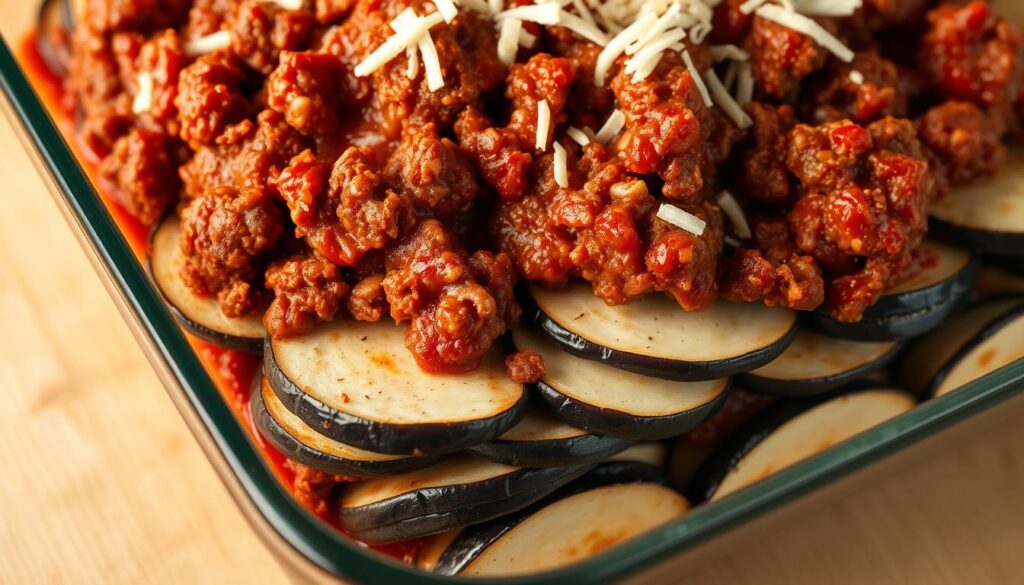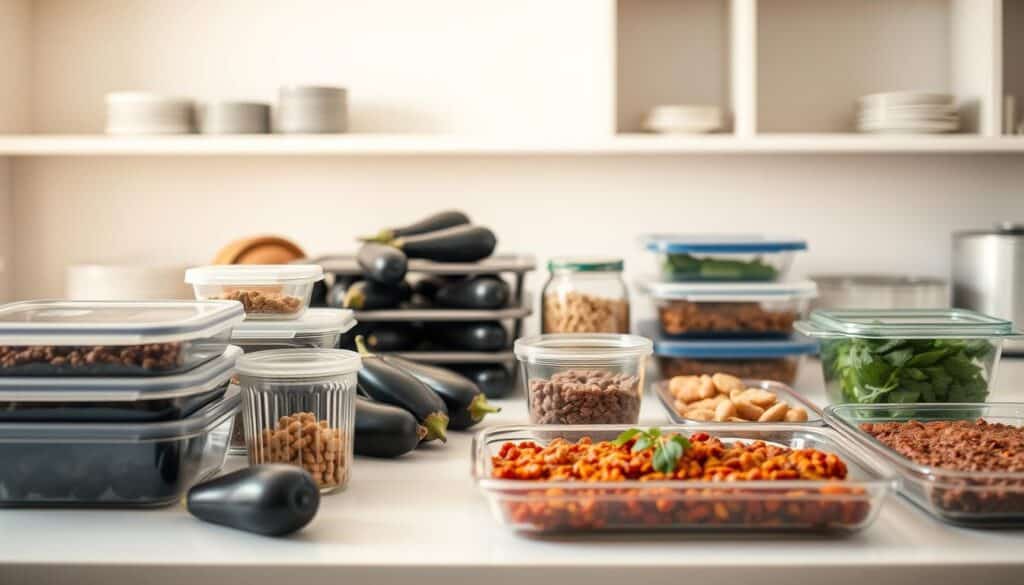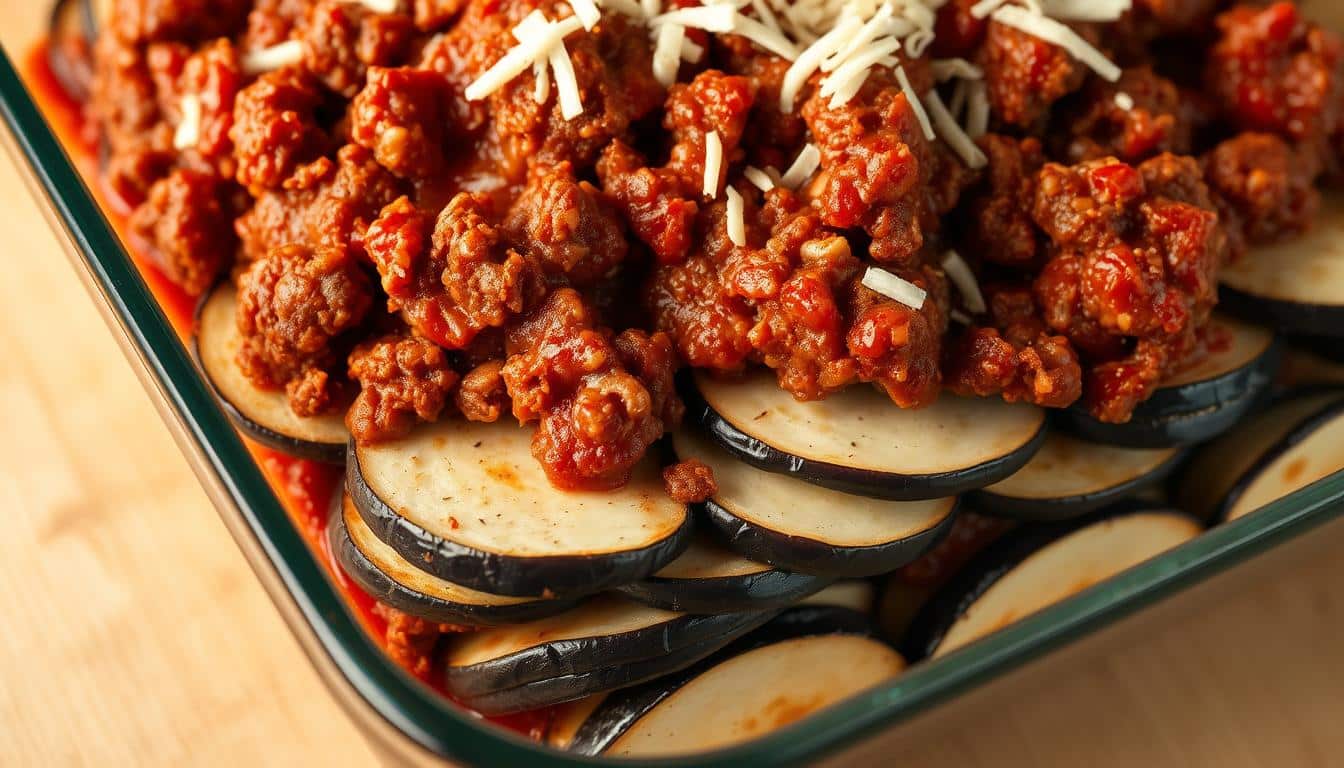There’s something special about a dish that warms the heart and brings people together. For me, that dish is authentic Greek moussaka. I still remember the first time I tasted it—each layer was a perfect harmony of flavors, from the tender eggplant to the rich, savory beef and the creamy béchamel sauce on top. It was more than just a meal; it was a cultural embrace.
Thank you for reading this post, don't forget to subscribe!At its core, moussaka is a celebration of simplicity and tradition. The recipe relies on a few key ingredients: fresh, thinly sliced eggplant, premium olive oil, and a béchamel sauce that’s both creamy and light. This isn’t just a casserole; it’s a dish that tells a story of heritage and home.
In this article, I’ll guide you through the authentic Greek moussaka recipe that’s been perfected over generations. You’ll learn the traditional preparation methods, from roasting the eggplant to crafting the béchamel sauce. By the end, you’ll have a foolproof recipe that’s sure to become a family favorite.
Whether you’re a seasoned cook or just starting your culinary journey, this moussaka recipe will deliver a dish that’s both comforting and flavorful. Let’s dive in and explore the layers of this beloved Greek classic.

Key Takeaways
- Learn the authentic Greek moussaka recipe with layers of roasted eggplant, savory beef, and creamy béchamel sauce.
- Discover the importance of using fresh, high-quality ingredients like eggplant and olive oil.
- Master traditional Greek techniques for preparing each layer of the dish.
- Get a foolproof recipe perfected over time for consistent results.
- Understand the cultural significance of moussaka as a comfort food with deep roots.
Introduction and Embracing Greek Comfort Food
There’s something truly heartwarming about a dish that brings people together, and for me, that dish is authentic Greek moussaka. My journey with this beloved recipe began many years ago, and it has since become a cherished staple in my kitchen.
My Journey with Traditional Recipes
I still recall the first time I tasted moussaka. Each layer was a perfect harmony of flavors, from the tender eggplant to the rich, savory beef and the creamy béchamel sauce on top. It was more than just a meal; it was a cultural embrace.
Why Moussaka Holds a Special Place in My Kitchen
At its core, moussaka is a celebration of simplicity and tradition. The recipe relies on a few key ingredients: fresh, thinly sliced eggplant, premium olive oil, and a béchamel sauce that’s both creamy and light. This isn’t just a casserole; it’s a dish that tells a story of heritage and home.
In this article, I’ll guide you through the authentic Greek moussaka recipe that’s been perfected over generations. You’ll learn the traditional preparation methods, from roasting the eggplant to crafting the béchamel sauce. By the end, you’ll have a foolproof recipe that’s sure to become a family favorite.
Whether you’re a seasoned cook or just starting your culinary journey, this moussaka recipe will deliver a dish that’s both comforting and flavorful. Let’s dive in and explore the layers of this beloved Greek classic.
Greek Moussaka: A gratin of eggplant, minced meat and béchamel.
The heart of this beloved dish lies in its layers. Tender eggplant slices, robust minced meat, and a creamy béchamel sauce come together to create a harmonious blend of flavors and textures.
The meat sauce is a cornerstone, made with ground beef (or lamb) and simmered to perfection. It melds beautifully with the natural sweetness of the eggplant, creating a rich, savory profile. Quality ingredients are key here—fresh eggplant, premium olive oil, and a well-seasoned meat sauce ensure each bite is satisfying.
The oven plays a crucial role, transforming the dish into a golden masterpiece. The béchamel sauce atop bakes to a golden brown, while the eggplant and meat layers set perfectly. A subtle sprinkle of cinnamon adds warmth, enhancing the overall depth without overpowering the dish.
| Component | Details |
|---|---|
| Eggplant | Tender, thinly sliced |
| Meat Sauce | Ground beef or lamb, well-seasoned |
| Béchamel Sauce | Creamy, golden brown |
| Oven | 180°C for 45 minutes |
| Cinnamon | Subtle warmth |
Each element works together seamlessly, creating a dish that’s both nourishing and flavorful. For more on crafting delicious sauces, visit our chicken in tomato sauce recipe.
Sourcing and Prepping Fresh Ingredients
When it comes to creating an authentic dish, the quality of your ingredients is just as important as the recipe itself. For this moussaka, selecting the right components is key to achieving that perfect balance of flavors and textures.
Choosing the Best Eggplant and Meats
Selecting the right eggplant can make all the difference. Look for large, firm eggplants with a glossy appearance. These will have fewer seeds and less bitterness. For the meat, ground beef or lamb works beautifully, but ensure it’s freshly ground for the best flavor. If you’re using potatoes, choose high-starch varieties like Maris Piper for a sturdy base.
Essential Tips for Salting and Slicing
Salting your eggplant slices is a crucial step to remove bitterness and excess moisture. Sprinkle both sides generously with salt and let them sit for about 30 minutes. After salting, rinse and pat them dry before slicing. Aim for uniform, 1/4-inch thick slices to ensure even cooking. If using potatoes, slice them similarly for consistency.
Fresh onions and a good olive oil are vital for enhancing the dish’s flavor. Sauté onions until soft and translucent to bring out their natural sweetness. Use a high-quality olive oil for sautéing to add depth without overpowering the other ingredients. When it comes to binding, a little flour and egg can go a long way in holding the layers together without making the dish heavy.
Remember, the key to a great moussaka is in the preparation. Taking the time to properly salt, slice, and cook each component ensures a dish that’s both nourishing and flavorful. It’s all about balance and attention to detail.
Creating the Perfect Meat Sauce
The foundation of a memorable dish often lies in its sauce, and this is especially true for the meat sauce in moussaka. A well-crafted sauce can elevate the entire dish, making each bite a delight.
Balancing Spices and Seasonings
Achieving the right balance of spices is crucial. Cinnamon and oregano are key players, adding warmth and depth without overwhelming the dish. These spices complement the tomato base beautifully, creating a harmonious flavor profile.
Simmering Techniques for Maximum Flavor
Simmering the sauce is where the magic happens. Allowing it to cook slowly ensures that all the ingredients meld together seamlessly. This process not only enhances the flavor but also results in a thick, rich texture that’s essential for the dish.
Proper heat management in the pan is essential to prevent burning and ensure even cooking. A small amount of fat helps keep the sauce moist during simmering, while using each ingredient in the right measure transforms it into a flavor powerhouse.
Crafting a Creamy Béchamel Sauce
The crowning glory of any moussaka is its béchamel sauce—a luxurious, creamy topping that binds the dish together. Creating a smooth, velvety béchamel is an art that requires attention to detail and a bit of patience.
Tempering Eggs for a Smooth Texture
To start, melt butter over medium heat in a saucepan. Add flour and stir continuously for about 2 minutes to create a roux, cooking until it’s just fragrant but not browned. Gradually pour in warm milk, whisking constantly to avoid lumps. This step ensures the sauce remains silky and even.
Next, temper the egg by slowly adding a spoonful of the warm béchamel to the beaten egg. This prevents the egg from curdling when added to the hot sauce. Once tempered, gently stir the egg mixture back into the saucepan. Continue cooking until the béchamel thickens, coating the back of a spoon evenly.
| Component | Details |
|---|---|
| Butter | ½ cup, unsalted |
| Flour | 6 tablespoons, all-purpose |
| Milk | 4 cups, whole |
| Egg | 1 large, beaten |
| Cooking Temperature | Medium heat |
As the sauce thickens, reduce the heat to low and let it simmer for a few minutes until it reaches your desired consistency. The key to a perfect golden brown top is precise temperature control during baking. With these steps, your béchamel will crown your moussaka beautifully, adding a rich, creamy finish to this beloved dish.
Step-by-Step Assembly and Layering Techniques
Assembling a dish with layers of flavors and textures can be both an art and a science. For this recipe, careful layering ensures each bite is balanced and delicious.
Arranging Eggplant and Meat Layers
Start by spreading a thin layer of meat sauce at the bottom of a well-oiled pan. Next, arrange the pre-cooked eggplant slices evenly, making sure to cover the entire surface. Repeat this process, alternating between layers of meat sauce and eggplant, until all ingredients are used, finishing with a layer of eggplant on top.
The Secret to a Crispy Breadcrumb Top
For a delightful crunch, sprinkle a thin layer of breadcrumbs over the top eggplant layer. Drizzle lightly with oil and bake in a preheated oven at 392°F (200°C) for about 30 minutes, or until golden brown. This step adds a satisfying texture to the dish.

By following these steps, you’ll create a dish where each layer complements the others, resulting in a harmonious blend of flavors and textures that’s sure to impress.
Baking to Golden Perfection and Serving Warm
Baking is where all the flavors and layers of your dish come together. The oven plays a crucial role in achieving that irresistible golden-brown crust on top.
Achieving that Irresistible Golden Browning
To start, preheat your oven to 375°F (190°C). This ensures consistent heat distribution. Place the moussaka in the center of the oven to avoid hot spots. The baking time is typically around 45 minutes, but keep an eye on it after 35 minutes to ensure the top doesn’t overcook.
Monitor the top layer closely. When it starts to brown, you can cover the edges with foil to prevent burning. This ensures an even, golden finish. If you prefer a crisper top, increase the oven temperature to 400°F (200°C) for the last 10 minutes of baking.
Once baked, let the dish rest for 15 minutes before serving. This allows the layers to set, making each bite cohesive and flavorful. Serve warm for the best texture and taste.
Presentation is key. A nicely plated dish invites everyone to the table. Pair it with a fresh side salad to balance the richness. Whether it’s a family dinner or a special occasion, this moussaka is sure to impress.
Creative Recipe Variations and Adaptations
Exploring different twists on a classic dish can breathe new life into a favorite recipe. This dish is no exception, offering plenty of opportunities for creativity.
Vegetarian and Vegan Alternatives
If you’re looking for a plant-based version, consider substituting the beef with roasted lentils or mushrooms. These options maintain a hearty texture while keeping the dish vegetarian. For a vegan version, replace the béchamel sauce with a dairy-free alternative made from plant-based milk and vegan butter. This way, you can still enjoy a creamy topping without compromising on flavor.
Adding Potatoes for an Extra Twist
Thinly sliced potatoes make a wonderful addition, adding a satisfying crunch to the dish. Simply layer them alongside the eggplant for a robust base. This potato version is perfect for those who prefer a bit more heft in their meal.
Whether you’re vegetarian, vegan, or just looking to mix things up, these variations offer delicious ways to enjoy this classic dish. Pair any version with a crisp salad for a well-rounded meal that’s sure to please.
Make-Ahead and Freezer Storage Tips
Planning ahead can make cooking easier, especially for dishes like this hearty casserole. With a few simple strategies, you can prepare components in advance and store them properly, ensuring a stress-free cooking experience.
Preparing Components in Advance
You can roast the eggplant slices and cook the meat sauce up to two days in advance. Store them in separate airtight containers in the refrigerator to maintain texture and flavor. The béchamel sauce can also be made ahead and refrigerated for up to a day.
Reheating Without Losing Flavor
When reheating, use a baking sheet lined with parchment paper to ensure even warming. Place the components in a preheated oven at 350°F for about 10-15 minutes, or until warmed through. For leftovers, reheat in the microwave or oven until just heated, taking care not to overcook.
| Component | Storage Tips | Reheating Method |
|---|---|---|
| Eggplant | Store in an airtight container in the fridge for up to 2 days | Oven at 350°F for 10 minutes |
| Meat Sauce | Refrigerate in an airtight container for up to 2 days | Microwave or oven until heated through |
| Béchamel Sauce | Keep refrigerated for up to 1 day | Gently warm on low heat, whisking constantly |
By following these tips, you can enjoy a delicious, stress-free meal perfect for gatherings. Mastering make-ahead techniques ensures your dish tastes as good as freshly made, every time.

Cooking Tips and Common Pitfalls to Avoid
Achieving perfection in your dish requires attention to detail and avoiding common mistakes. Here are some practical tips to help you enhance the flavor and texture of your final dish while steering clear of pitfalls.
Simple Tricks to Enhance the Final Dish
Start by seasoning your ground meat evenly. Avoid overusing spice and pepper, as they can overpower the dish’s delicate balance. Ensure your oven is preheated to the correct temperature to maintain even cooking and prevent burning.
When preparing the eggplant slices, slice them uniformly to ensure consistent cooking. Monitor the amount of flour and oil used in the béchamel sauce to keep it smooth and lump-free. Properly salting the eggplant slices before cooking can help remove excess moisture and bitterness.
| Tip | Details |
|---|---|
| Seasoning | Use pepper sparingly to avoid overpowering the dish. |
| Eggplant Preparation | Slice eggplant evenly for consistent cooking. |
| Oven Management | Preheat the oven to 375°F (190°C) for even cooking. |
| Sauce Preparation | Monitor flour and oil to avoid lumps in the béchamel. |
Avoid common mistakes like unevenly cooked ground meat or under-whisked sauce. For more tips on crafting delicious sauces, visit our moussaka recipe for inspiration. By following these tips, you’ll create a dish that’s both nourishing and flavorful.
Conclusion
As we conclude our journey through the layers of this beloved dish, it’s clear why this recipe holds a special place in many hearts. By carefully selecting fresh ingredients and following traditional steps, you’ve crafted a dish that’s both nourishing and flavorful.
The key to success lies in the harmony of its components: the tender eggplant, the rich meat sauce, and the creamy sauce that binds them together. Each layer contributes to a delightful balance of textures and tastes, making every bite memorable.
I encourage you to try this authentic recipe, which combines tradition with adaptability. Whether you’re preparing it for a family gathering or a cozy night in, it’s sure to become a favorite. Don’t hesitate to experiment with the variations and make-ahead tips provided to enjoy this comforting meal again and again.
Thank you for joining me on this culinary journey. Remember, a great recipe, like any great story, is meant to be shared. Bon appétit!
FAQ
Can I use other vegetables besides eggplant in this recipe?
Yes! While eggplant is traditional, you can add potatoes or zucchini for extra flavor and texture. Slice them thinly and layer them just like the eggplant.
How do I prevent the eggplant from tasting bitter?
Salting the eggplant slices and letting them sit for about 30 minutes can draw out moisture and reduce bitterness. Rinse and pat dry before using.
What’s the best type of meat to use for the sauce?
Ground beef is classic, but you can also use a mix of beef and pork for richer flavor. Avoid very lean meats to keep the sauce hearty.
Can I make this dish ahead of time?
Absolutely! Assemble the moussaka up to a day in advance and refrigerate. Bake when you’re ready. It also freezes well for up to 3 months.
How do I achieve a crispy breadcrumb topping?
Mix breadcrumbs with a little olive oil and sprinkle them evenly over the top. Bake until golden for a crunchy finish.
What’s the secret to a smooth béchamel sauce?
Temper the milk slowly into the roux, whisking constantly to avoid lumps. Cooking it over medium heat ensures a creamy texture.
Can I make a vegetarian version of this dish?
Sure! Replace the meat sauce with a hearty tomato and vegetable mixture. Layer with eggplant and top with béchamel for a satisfying vegetarian meal.
How long should I bake the moussaka?
Bake at 375°F (190°C) for about 45-50 minutes, or until the top is golden brown and the sauce is bubbly.
What’s the best way to serve moussaka?
Let it rest for 10-15 minutes before slicing. Serve warm, perhaps with a fresh salad or crusty bread on the side.
Can I use store-bought tomato sauce?
While homemade sauce is best, you can use a high-quality store-bought option. Just add your own spices for extra flavor.
There are no reviews yet. Be the first one to write one.

